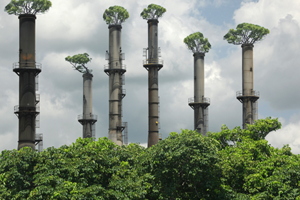Securing the future of renewables
Carbon Capture and Storage
Securing the future of renewables
The inherent intermittency of renewable energy means that for technologies such as wind, solar and wave to be adopted at scale, they must – ironically - be supported by flexible fossil fuel power to cope with demand, at least in the medium term. At the CO2 Technology Centre Mongstad, the only large scale gas-fired test centre, an amine carbon capture unit can scale the CO2 capture rate from zero to 90 percent CO2 removal (3,2 tonnes of CO2 per hour) in less than two hours - mimicking a power surge scenario of the grid going from full renewables reliance to reliance on fossil fuels.
 |
| (c) REDAV |
Take Germany, where the Energiewende has given rise to major renewables reliance. Great news, but the intermittency puts a strain on European power grids. During periods of low generation and high demand Germany is forced to rely upon French nuclear power plants, as well as using coal-generated power from neighbours such as Poland to meet the demand. Carbon capture technologies can manage the rapid switch between renewable and fossil fuel generated power when needed, whilst limiting the release of CO2.
Another example of where CCS makes renewables more viable is in the industrial sector. Cement, iron, steel, chemical and refining plants together make up 20 percent of global emissions. Renewables, especially solar, hold huge potential for reducing costs of the industrial sector. At the moment carbon capture is one of the few viable ways to enable the sector to transition to a large proportion of renewable generation, whilst limiting greenhouse gases.
The flexibility of CCS can bridge the gap between fossil fuels and renewables, encouraging investment in both to meet the IEA’s target for renewables to make up 23 percent of global emissions reductions and CCS to make up 17 percent in 2050. Indeed, the IEA has urged governments and industry to ensure that the incentive and regulatory frameworks are in place to deliver upwards of 30 operating CCS projects by 2020 across a range of processes and industrial sectors.
The major challenge for CCS is
| The major challenge for CCS is to make the technology economically viable to adopt for power plants, refineries, cement plants and other industrial facilities |
An understanding of the economic risks of carbon reliance is rising. HSBC has estimated that in a world where carbon emissions are constrained, oil and gas companies could lose 40 to 60 percent of their market capitalisation. Yet the colossal amount of fossil fuels investment in existing fossil fuel reserves will take some time to be transitioned. As a result there are huge economic prizes on offer to technologists that can rise to the challenge of protecting that economic value, by decarbonising fossil fuels.
The Obama administration has announced plans to provide $8 billion in loan guarantees for low-carbon fossil projects to promote further carbon capture. Similarly, China is planning to double its budget for carbon capture projects, hoping to attract some $380 million in investment over the next five years for the carbon-capture industry. There are also notable projects likely to come on stream. In the UK, for example, the Department of Energy and Climate Change (DECC) recently funded Front End Engineering and Design (FEED) studies for projects at White Rose and Peterhead in December 2013 and February this year respectively. With Peterhead in particular, the FEED studies will help to de-risk the project’s investigation into capturing more than 85 percent of CO2 emissions that will then be stored in a depleted gas reservoir in the North Sea with the aim of providing 500,000 homes with clean electricity. In Canada the ‘Boundary Dam project’ will be on stream in 2014 with plans to capture 1Mt/year of CO2. The total cost of the project is estimated to be $1.355 billion, and the revenue from the sale of CO2 is expected to offset the project costs. Sulphur dioxide (SO2) will also be captured and sold.
Here at TCM, we can’t wait for emission trading systems and carbon taxes to drive the industrialisation of CCS.
| Here at TCM, we can’t wait for emission trading systems and carbon taxes to drive the industrialisation of CCS |
- TCM is a joint venture between Gassnova (on behalf of the Norwegian state), Statoil, Shell and Sasol.
- The International Energy Agency (IEA) World Energy Outlook 2012.